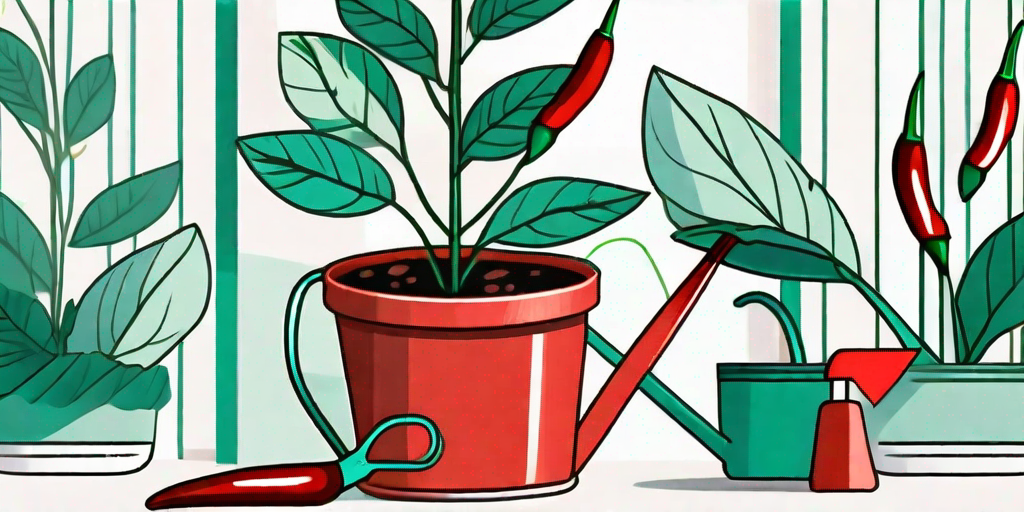
If you're a fan of the spicy life, then Thai chili plants are your ticket to a fiery paradise. These little guys are not just a great addition to your garden, but they also pack a punch in the kitchen. So, let's get down to the nitty-gritty of growing and caring for Thai chili plants.
Understanding Thai Chili Plants
Before we dive into the how-to's, let's take a moment to appreciate the Thai chili plant. Native to Thailand, these plants are known for their small, fiery fruits that are a staple in Thai cuisine. They're also known as bird's eye chili due to their small size and the fact that birds, with their lack of capsaicin receptors, love them.
Thai chili plants are perennials, which means they can live for more than two years. However, in colder climates, they're often grown as annuals. They typically grow to about 1-2 feet in height and bear fruits that are about 1 inch long. The fruits start out green and turn red as they mature.
The Heat Factor
Now, let's talk about the heat. Thai chili peppers are known for their intense spiciness, which is measured in Scoville Heat Units (SHU). On average, Thai chili peppers range from 50,000 to 100,000 SHU. To put that into perspective, jalapenos range from 2,500 to 8,000 SHU. So, yes, Thai chili peppers are not for the faint-hearted.
But don't let the heat scare you away. The spiciness of Thai chili peppers is balanced by a fruity flavor that adds depth to dishes. Plus, capsaicin, the compound that gives chili peppers their heat, has health benefits, including boosting metabolism and reducing inflammation.
How to Grow Thai Chili Plants
Now that we've covered the basics, let's get to the fun part: growing your own Thai chili plants. Don't worry, it's not as hard as it might seem. All you need is a little patience, some basic gardening tools, and a love for all things spicy.
Here's a step-by-step guide:
- Choose the Right Seeds: Start by choosing high-quality Thai chili seeds. You can find them at your local garden center or online.
- Start Indoors: Thai chili plants are tropical, which means they need a long, warm growing season. In most climates, it's best to start the seeds indoors 6-8 weeks before the last expected frost.
- Plant the Seeds: Plant the seeds in a seed-starting mix, about 1/4 inch deep. Keep the soil moist but not waterlogged.
- Provide Light and Heat: Place the seedlings in a sunny window or under grow lights. They also need warmth, so maintain a temperature of around 70-85 degrees Fahrenheit.
- Transplant Outdoors: Once the seedlings have 2-3 true leaves and the danger of frost has passed, you can transplant them outdoors. Choose a spot with full sun and well-draining soil.
- Water and Fertilize: Water the plants regularly, but don't let them sit in water. Fertilize every 2-3 weeks with a balanced fertilizer.
- Harvest: Harvest the peppers when they're red and fully mature. Be careful, though. It's best to wear gloves when handling these spicy fruits.
Caring for Thai Chili Plants
Thai chili plants are relatively easy to care for, but they do have some specific needs. Here are some tips to keep your plants happy and productive:
- Watering: Thai chili plants like evenly moist soil. However, they don't like waterlogged soil, so make sure the soil drains well.
- Light: These plants love the sun. They need at least 6 hours of direct sunlight each day.
- Temperature: Thai chili plants are tropical, so they prefer warm temperatures. They can't tolerate frost, so if you live in a colder climate, consider growing them in pots so you can bring them indoors in winter.
- Fertilizing: Feed your plants every 2-3 weeks with a balanced fertilizer. This will help them produce lots of spicy fruits.
- Pest Control: Watch out for pests like aphids and spider mites. If you notice any, treat the plants with a natural insecticide.
FAQs
How long does it take for Thai chili plants to bear fruit?
Thai chili plants typically start bearing fruit 2-3 months after planting. However, the exact timing can vary depending on the growing conditions.
Can I grow Thai chili plants indoors?
Yes, Thai chili plants can be grown indoors. They need lots of light, so place them in a sunny window or under grow lights. They also need a warm environment, so keep the temperature around 70-85 degrees Fahrenheit.
Are Thai chili peppers the same as bird's eye chili?
Yes, Thai chili peppers are also known as bird's eye chili. They got this name because of their small size and because birds, which don't feel the heat of capsaicin, love them.
How hot are Thai chili peppers?
Thai chili peppers are quite hot. On average, they range from 50,000 to 100,000 Scoville Heat Units (SHU). To put that into perspective, jalapenos range from 2,500 to 8,000 SHU.
Conclusion
So, there you have it, folks. Growing and caring for Thai chili plants is not just a fun and rewarding hobby, but it's also a great way to spice up your life. With a little patience and care, you'll be able to enjoy your own homegrown, fiery Thai chili peppers. So, why not give it a try? After all, life's too short to eat bland food.











